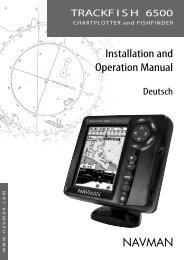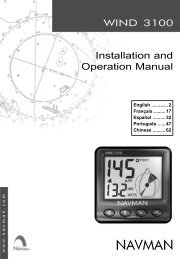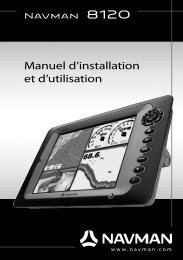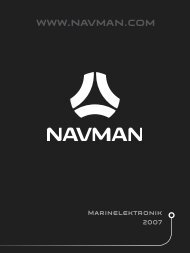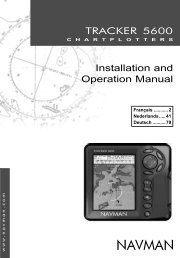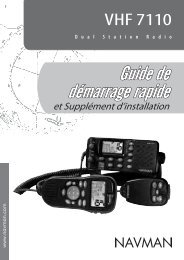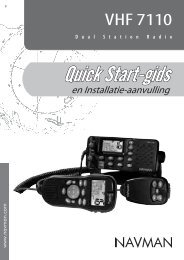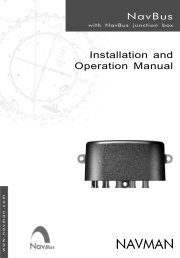English - Navman Marine
English - Navman Marine
English - Navman Marine
Create successful ePaper yourself
Turn your PDF publications into a flip-book with our unique Google optimized e-Paper software.
1 Introduction<br />
Congratulations on choosing a <strong>Navman</strong> Þ sh-<br />
Þnder. For maximum beneÞt, please read this<br />
manual carefully before installation and use.<br />
This manual describes how to install and set<br />
up the FISH 4350 or FISH 4380. Refer to<br />
seperate Transducer Installation Instructions<br />
supplied with the transducer.<br />
1-1 BeneÞts of the FISH 4350 and FISH 4380<br />
The FISH 4350 and FISH 4380 are high quality<br />
ÞshÞnders that are supplied with a transducer.<br />
Both use TFT (Thin Film Transistor) technology<br />
to provide a colour display for easy daylight<br />
viewing. The LED backlight can be dimmed for<br />
night Þshing. The bracket mounting option also<br />
allows the ÞshÞnder to be tilted and swivelled for<br />
optimum viewing.<br />
The colours on the sonar displays are customizable,<br />
with a choice of four 16 colour<br />
palettes and one 8 colour palette. The colours<br />
represent different signal strengths, making the<br />
sonar displays easy to interpret.<br />
This capability, combined with a variable power<br />
output of up to 200 W RMS, ensures that the<br />
FISH 4350 and FISH 4380 operate effectively<br />
in shallow and deep water.<br />
The FISH 4350 and FISH 4380 can detect the<br />
bottom to a depth of 600 feet (180 metres)<br />
depending on the clarity of the water and the<br />
type of transducer used.<br />
The <strong>Navman</strong> ÞshÞnder can be used to Þnd Þsh,<br />
to locate features on the bottom such as reefs<br />
or wrecks and to help recognize favourite Þshing<br />
spots from the bottom proÞle.<br />
The <strong>Navman</strong> fishfinder can also assist with<br />
This manual also explains how to operate the<br />
FISH 4350 and FISH 4380 effectively and gives<br />
troubleshooting and performance tips.<br />
Important<br />
It is vital to the performance of the ÞshÞnder<br />
that the transducer is installed in the best<br />
location. Please follow the installation<br />
instructions very carefully.<br />
navigation by providing depth information to help<br />
identify the depth contours marked on charts.<br />
IMPORTANT NOTE ON USE. While any<br />
ÞshÞnder can be used as an aid to navigation,<br />
accuracy can be limited by many factors,<br />
including the location of the transducer. It is<br />
the user’s responsibility to ensure the <strong>Navman</strong><br />
ÞshÞnder is installed and used correctly.<br />
With the optional fuel kit, the FISH 4380 also<br />
becomes a sophisticated and easy-to-use<br />
fuel computer.<br />
All of the <strong>Navman</strong> 4000 Series fishfinders<br />
use proprietary SBN Technology for sonar<br />
processing to improve Signal enhancement,<br />
Bottom recognition and Noise rejection.<br />
SBN Technology uses digital adaptive filter<br />
algorithms to enhance all returned signals. At the<br />
same time, SBN Technology uses active noise<br />
control to reject interference, which can often be<br />
mistaken by ÞshÞnders for true returns.<br />
Using SBN Technology, the <strong>Navman</strong> ÞshÞnder<br />
analyses the reßections from each pulse, Þlters<br />
false returns and displays what is in the water<br />
under the boat. See section 4-1 Interpreting the<br />
display, for more information.<br />
1-2 How the FISH 4350 and FISH 4380 work<br />
The FISH 4350 and FISH 4380 have two parts:<br />
- the transducer attached to the hull<br />
- the display unit.<br />
The transducer generates an ultrasonic pulse<br />
(sound that is above the hearing range of the<br />
human ear), which travels down towards the<br />
bottom at a speed of about 4800 ft/sec (1500 m/<br />
sec), spreading out into a cone shape.<br />
When the pulse meets an object, such as a<br />
Þsh or the bottom, it is partly reßected back up<br />
towards the boat as an echo. The depth of the<br />
object or bottom is calculated by the FISH 4350<br />
and FISH 4380 by measuring the time taken<br />
between sending a pulse and receiving the<br />
echo. When an echo has been returned, the<br />
next pulse is sent.<br />
The FISH 4350 and FISH 4380 convert each<br />
echo into an electronic signal, displayed as a<br />
vertical line of pixels. The most recent echo<br />
appears on the extreme right of the display, with<br />
4 NAVMAN<br />
FISH 4350 / 4380 Installation and Operation Manual




